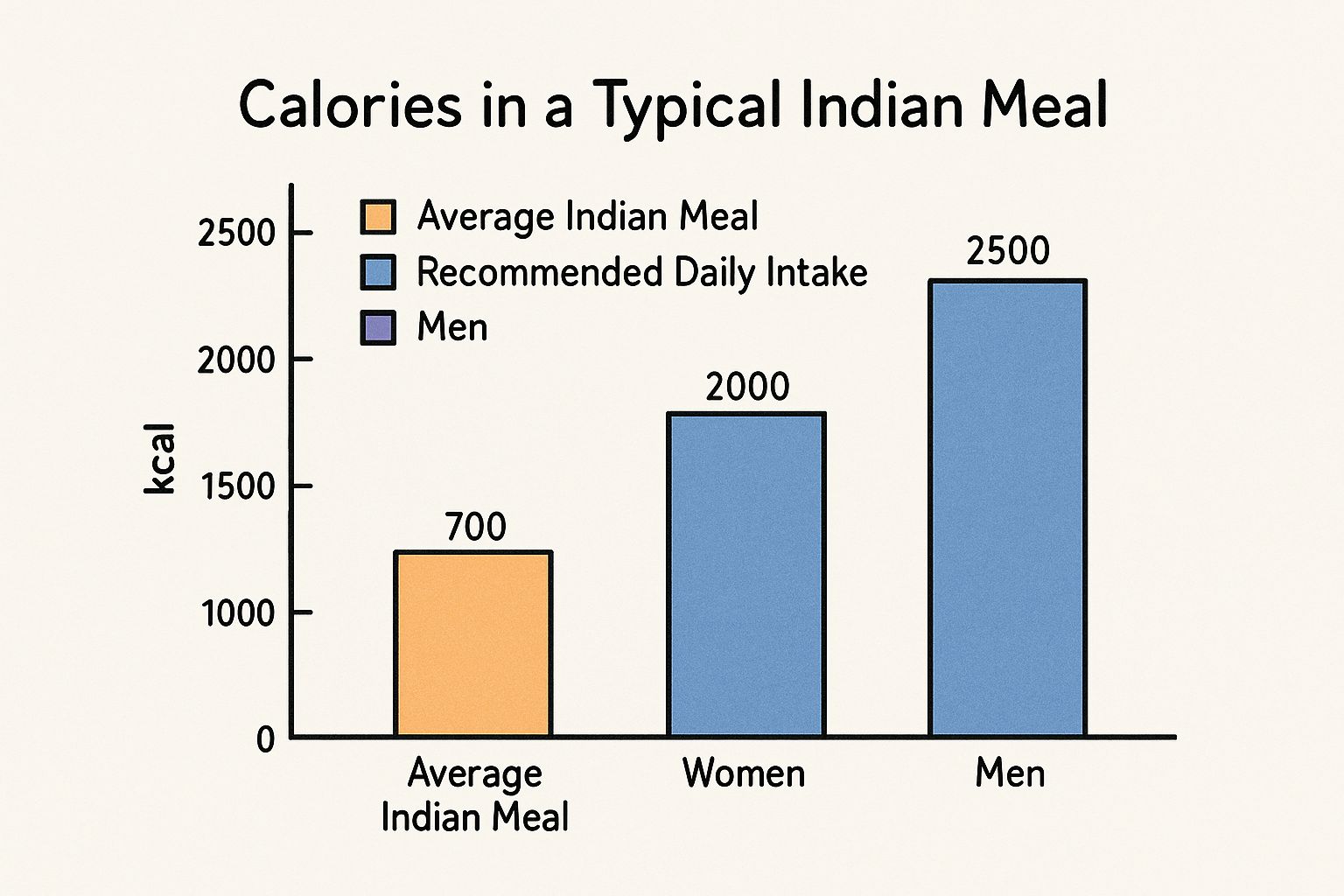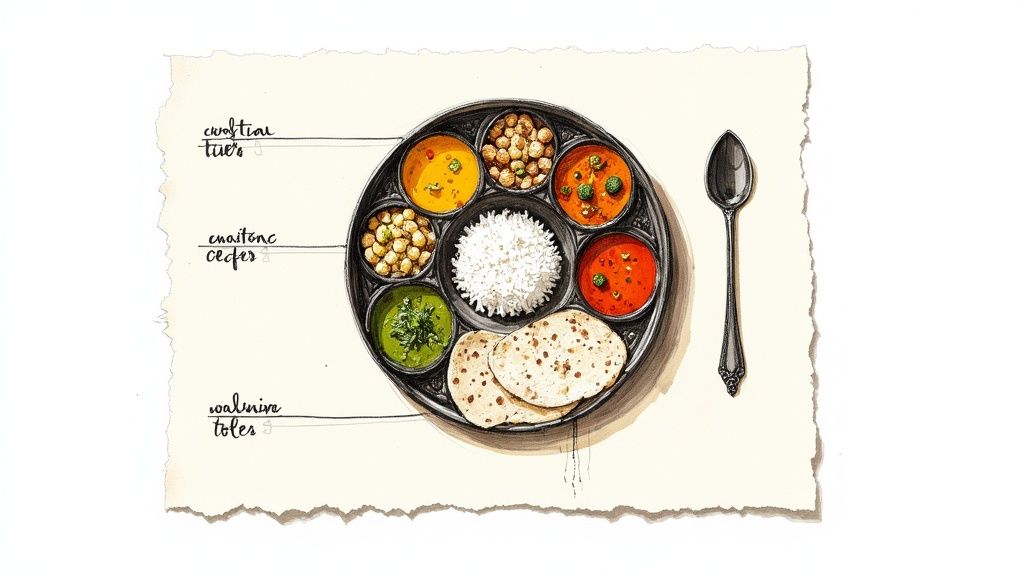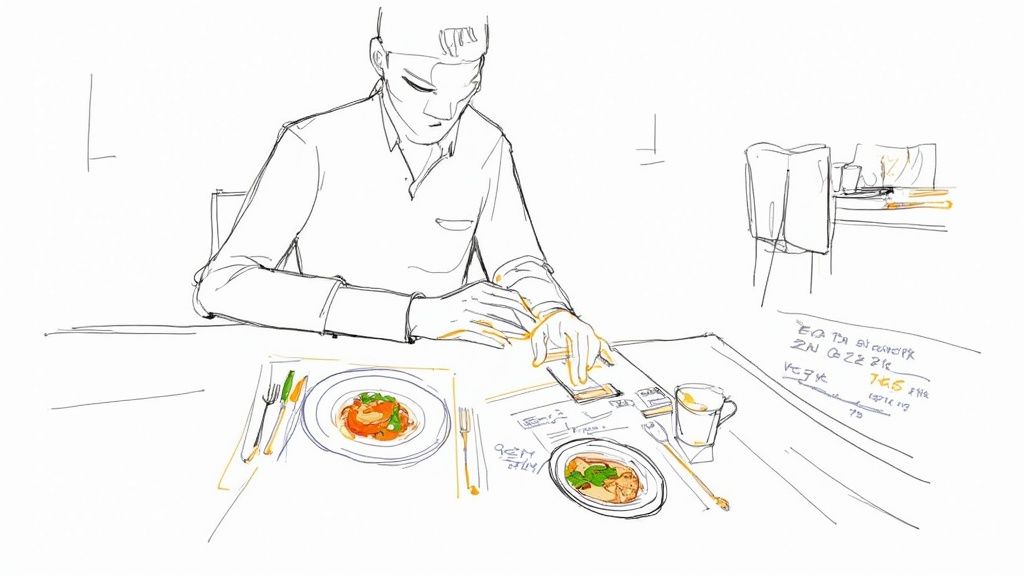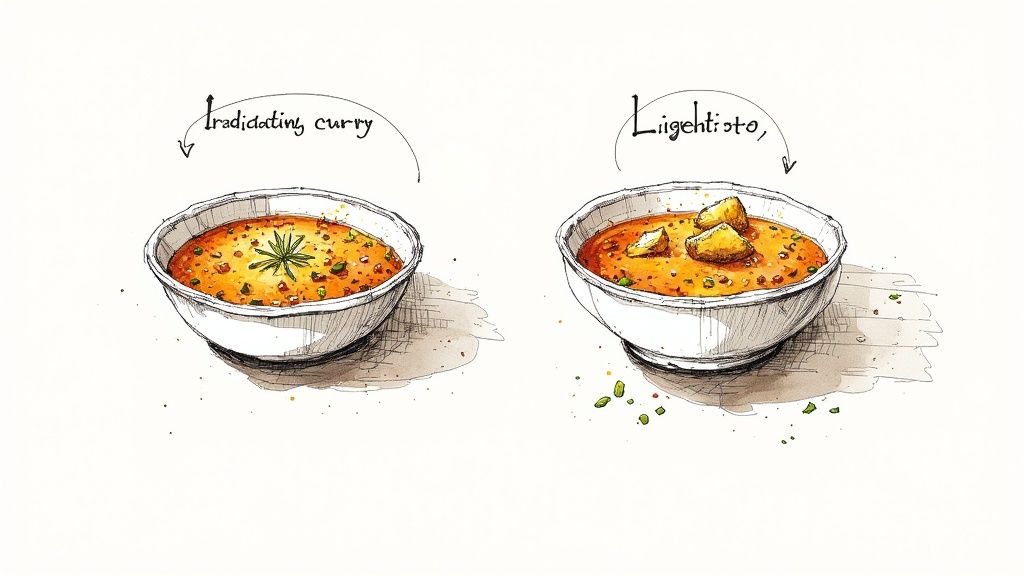A Simple Calorie Counter for Indian Food
Tired of guessing? Use our simple calorie counter for Indian food. This guide shows you how to track meals like dal and roti without the stress.
Posted by
Trying to use a generic calorie counter for indian food often feels like you're just guessing. Sound familiar? The problem isn't your food; it's that most apps don't get the difference between a store-bought wrap and a homemade roti, or the unique blend of spices in your family's dal recipe.
Why Is Indian Food So Hard To Track?
If you've ever felt like giving up on tracking your Indian meals, you're not alone. The very things that make our food so incredible—its richness, variety, and home-cooked nature—are what make it a bit of a puzzle for standard calorie-counting apps.
Think about your favorite dishes. Your mom’s rajma recipe or that perfect chicken biryani from a local spot won't be in any generic database. It’s not just about the main ingredients; it's how it's all put together that matters.
Where Most Apps Fall Short
The main roadblocks usually boil down to a few common frustrations:
- Complex Recipes: Dishes like paneer butter masala or a good biryani have a long list of ingredients. Spices, pastes, and different oils are all cooked together, and trying to break that down manually is a massive headache.
- The "Hidden" Fats: How much ghee is really on that paratha? How much oil went into the tadka for the dal? This can change a lot from one kitchen to another, and these fats can add up quickly.
- What's a "Serving" Anyway?: When you scoop some sabzi onto your plate, is that one "serving"? A small katori holds way less than a generous spoonful. Without standard portions, estimates feel like a complete shot in the dark.
For many people, this is the point where tracking feels too hard to continue. There's this idea that if you can't be 100% accurate, then what's the point?
But here’s a thought: what if the goal isn't absolute perfection, but better awareness?
Just getting a general sense of your meals is way more powerful than stressing over an extra 20 calories in your curry. If you want to get more specific about proteins, carbs, and fats, our guide on how to count macros is a great next step.
The real win is building a mindful connection with your food, not creating a perfect spreadsheet. Casual tracking helps you see the bigger picture—like noticing your weekday lunches are lighter than you thought, or that those weekend snacks are adding up more than you realized.
The struggle is real, but thankfully, the way we track our food is changing. Here’s a quick look at the old headaches versus a new, easier approach.
Common Challenges vs Effortless Solutions
| The Challenge | The Old Way | The Munchlog Way |
|---|---|---|
| Complex Home Cooking | Manually entering 15+ ingredients for one curry. | Simply say, "I had homemade rajma chawal." |
| Hidden Fats & Oils | Guessing the amount of ghee or oil used in a dish. | The AI asks, "Was it a restaurant-style curry or a light home-style one?" for a better estimate. |
| Guessing Portions | Trying to figure out if your bowl is a "small" or "medium" serving. | Describe it naturally: "I had a bowl of dal and two rotis." |
This shift from manual labor to a casual conversation makes all the difference, turning a chore into a simple, two-second habit.
This chart really puts things into perspective, showing how a typical Indian meal fits into your daily calorie needs.

As you can see, a single hearty meal can easily make up a big chunk of your daily energy. This is why being mindful of portions is so helpful.
This is exactly where a tool built for real life, not a science lab, comes in handy. An AI-powered app like Munchlog.ai lets you log what you ate just by speaking. What used to be a tedious task becomes a simple habit that actually works for Indian food.
Getting a Feel for Nutrition in Popular Indian Dishes

Let's break down the nutrition behind your favorite Indian meals. The goal isn't to get bogged down memorizing calorie charts, but to build a good gut feeling for what's on your plate. This lets you make smarter choices without the stress of perfection—which is the whole point of casual tracking.
When you look at a classic Indian meal, the ingredients themselves tell a story. A hearty bowl of rajma chawal is a great mix of protein and carbs. The rajma (kidney beans) gives you plant-based protein and fiber, while the rice provides the quick energy your body loves.
Now, compare that to something like a creamy paneer makhani. Paneer is loaded with both protein and fat, making it a much richer dish than a simple dal. Neither is "good" or "bad"—they just serve different nutritional roles. Getting this simple distinction down is the first real step to using a calorie counter for indian food effectively.
How Ingredients and Cooking Change Everything
It's not just what you eat, but how it's cooked. The preparation method can completely transform a dish's nutritional profile. A piece of chicken from the tandoor? That's lean and packed with protein because it's cooked with very little fat. But take that same piece of chicken and deep-fry it for a pakora, and it soaks up a ton of oil, sending its fat and calorie content way up.
The secret is simple: you don't need a nutrition degree to eat mindfully. Just ask yourself a basic question—is this dish lentil-based, creamy, grilled, or fried? That alone gives you a huge clue about what you're eating.
This kind of awareness helps you balance your meals over the course of a day. If you enjoyed a rich, creamy curry for lunch, you might naturally lean towards a lighter dal and sabzi for dinner. It’s all about making small, intuitive tweaks, not sticking to a set of rigid rules.
Thinking about your food this way is super practical. For example, while general guidelines might suggest around 2,100-2,400 calories per day, data shows that actual consumption can be quite different. You can dive deeper into these national trends in this detailed report.
This is why tracking with a voice-powered app is so freeing. You can just say, "I had a bowl of rajma with rice," and let the tech handle the complicated estimation part.
How to Estimate Portion Sizes Without a Scale
Let's be real—nobody wants to pull out a food scale at a family dinner. Obsessing over every single gram is not only stressful but completely impractical for a normal life.
The good news? You don't have to. You can get a pretty good estimate using a tool you carry with you everywhere: your own hands.
This whole approach is about making a "good enough" guess, which is more than enough for consistent, stress-free tracking. It lets you log your meals confidently, whether you’re eating at home or out at a restaurant. After a while, these visual cues become second nature.
Your Hands Are Your Best Calorie Counter
Think of your hand as your personal portioning guide. Since it’s proportional to your body, it’s a surprisingly useful way to estimate how much you’re eating.
Here are a few simple examples you can start using today:
- Protein (Chicken, Paneer, Fish): The palm of your hand (not including fingers) is your go-to here. A palm-sized portion is a solid estimate for about 85-115 grams of cooked protein.
- Carbs (Rice, Poha): A cupped hand is perfect for grains. One cupped handful is roughly half a cup, which is a standard serving for things like cooked rice.
- Fats (Nuts, Seeds): For this, just use your thumb. The tip of your thumb (from the top knuckle up) is about the size of one tablespoon—perfect for measuring out a serving of nuts or a dollop of ghee.
Remember, the goal isn't clinical precision. It's about building awareness. Knowing you had roughly one "fist" of rice is infinitely better than not tracking at all just because you couldn't weigh it.
This method pairs perfectly with a voice-logging tool like Munchlog.ai. You can simply say, “I had a palm-sized piece of tandoori chicken, a small bowl of dal, and two rotis.” The AI gets these natural descriptions and turns them into a nutritional estimate, making it the perfect calorie counter for Indian food when you're on the go.
Logging Homemade Indian Meals with Your Voice

So what if you could skip the manual data entry altogether? Using a smart calorie counter for Indian food like Munchlog.ai lets you turn even the most complex homemade meals into a quick voice note.
Let's say you just finished a fantastic home-cooked lunch. Normally, you’d have to pull out your phone, open an app, and individually search for every part of your meal. It's a real drag.
Instead, you can just say it out loud.
“Hey Munchlog, I had a bowl of my mom’s dal makhani, some basmati rice, and a small cucumber salad.”
And that's it. No need to list every spice, figure out the exact amount of ghee, or hunt for the "right" entry in a massive database. You just describe your meal naturally, like you're talking to a friend.
How Natural Language Makes Tracking Effortless
The real power here is how the AI understands what you're saying. It knows that "mom's dal makhani" probably isn't the super-rich, cream-laden version you'd get at a restaurant. It understands that "a bowl" and "some rice" are how we normally describe portions, and it generates a solid nutritional estimate from that context.
This completely sidesteps the biggest headache of food tracking: the tedious, manual logging. That’s why most people give up after a few days. With a voice-first approach, logging becomes a quick, two-second habit that actually fits into your daily routine.
If you’re looking for more ways to make tracking a breeze, check out our guide on finding an easy food tracking app.
By simply speaking your meals into existence, you get a clear, stress-free picture of your daily nutrition. It's the perfect solution for anyone who loves their Indian food but doesn't have the time or patience to get bogged down in the details of manual logging.
Don't Forget the Snacks and Chai

It’s one thing to track your main meals, but what about everything else? That mid-morning masala chai, the evening samosa, or even just a handful of roasted cashews can add up. These are the small bites and sips that punctuate our day, and they're just as important for getting a complete picture of your nutrition.
This isn’t about cutting things out—it’s about being aware.
Knowing that a single samosa can pack 150-200 calories, or that your favorite sweet lassi might have over 200 calories, helps you make mindful choices. Maybe you still enjoy the samosa but decide to skip the sugar in your next coffee. That's a win.
Just Say What You Ate
This is where logging gets really easy. You don’t need to pull out a scale for every little thing. Instead, just say it out loud.
Using Munchlog.ai: "I had a cup of chai with one sugar and two biscuits."
The app takes that simple sentence and gives you a solid estimate, no typing required. It removes the hassle that makes most people quit tracking in the first place, making it feel less like a chore and more like a quick thought.
By the way, if you're looking for lighter snack ideas, check out our guide on the calories in a fruit bowl for some inspiration.
Interestingly, while per capita calorie availability has increased in India, it's still below the global average. A USDA economic report shows that from 1990 to 2019, worldwide daily calorie availability per person grew by 13%, while India's growth was more modest. This context makes mindful tracking of everything—including snacks—even more valuable for understanding your own personal nutrition.
Answering Your Questions About Tracking Indian Food
Getting started with food tracking can feel a little intimidating, especially with meals as rich and varied as Indian cuisine. It’s completely natural to have questions. Let's walk through some of the common ones so you can feel confident from day one.
Remember, this isn't about getting a perfect score. It's about becoming more aware of what you're eating and building a healthier relationship with the food you love.
Just How Accurate Can a Calorie Counter Be for Indian Food?
Let's be real: no app can know the exact amount of ghee your mom adds to her dal makhani. And that's okay. The secret to successful tracking is consistency, not perfection.
A good calorie counter for Indian food, like Munchlog.ai, gives you a solid, reliable estimate. When you log your meals consistently, even with these estimates, you’ll start seeing the bigger picture of your eating habits. That insight is way more powerful than stressing over a few calories here and there.
Do I Really Need to Log Every Masala and Spice?
Absolutely not. In fact, trying to log every pinch of turmeric or coriander is a fast track to burnout. The calorie count in spices is so minimal it won't make a real difference in your daily total.
When you log a dish like "vegetable curry," the app's database already assumes a standard mix of spices is included. Your job is to focus on the main items: the vegetables, the protein (like paneer or chicken), and the primary fats (like oil or coconut milk).
The whole point of casual tracking is to keep it simple. You're aiming for a broad overview, not a forensic analysis of your plate. This low-stress mindset is what helps you build a lasting habit.
What About When I Eat at an Indian Restaurant?
Restaurant food is designed for maximum flavor, which usually means a more generous hand with oil, cream, and butter. My advice? Get a little more specific with your log entry.
Instead of just saying 'paneer masala,' try logging it as 'restaurant-style paneer butter masala.' The Munchlog.ai database is smart enough to have entries for common restaurant preparations, which carry higher calorie estimates to reflect that extra indulgence.
Interestingly, this mindful approach is especially relevant in India. Data shows the average Indian consumes about two-thirds of the calories compared to people in many other parts of the world, like Japan or China. You can dig into these global consumption patterns and see how different diets compare.
How Do I Handle a Meal with Lots of Shared Dishes?
Ah, the classic family-style Indian dinner! It's much simpler to track than you'd think. Forget trying to perfectly measure every spoonful from the communal bowls. Just estimate your own portions.
This is where voice logging really shines. You can capture the whole meal in one go with Munchlog.ai by saying something like, "I had a small bowl of palak paneer, some chana masala, and one naan." The app pieces it all together for a complete meal estimate. It’s all about being aware of what you put on your own plate.
Ready to stop guessing and start tracking your Indian meals the easy way? With munchlog.ai, you can log everything you eat just by talking. Give it a try and see how simple mindful eating can be. Visit us at https://munchlog.ai to learn more.